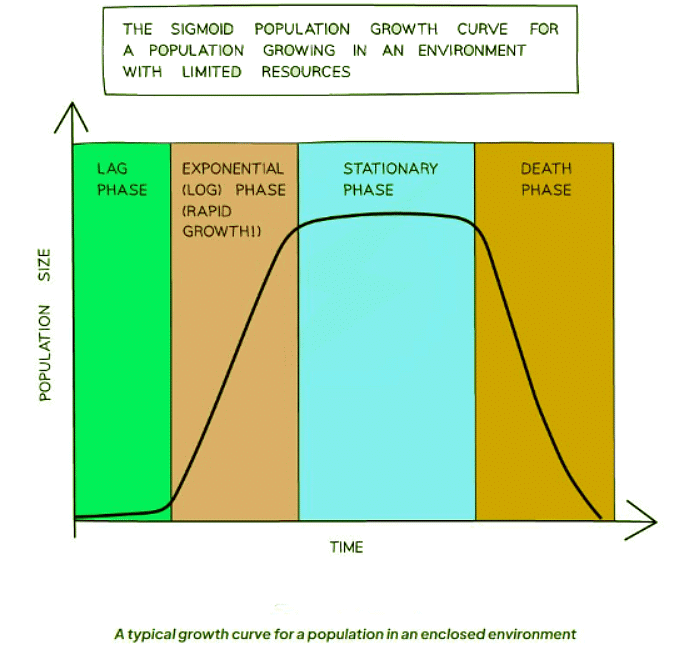Class 10 Exam > Class 10 Notes > Biology for GCSE/IGCSE > Populations
Populations | Biology for GCSE/IGCSE - Class 10 PDF Download
Definition of Population
- A population comprises organisms of the same species residing in a particular area simultaneously.
Other important definitions
- A community encompasses the various populations of different species existing within a specific ecosystem.
- An ecosystem constitutes a unit comprising the interacting community of organisms and their surrounding environment, such as a decomposing log or a lake.
Population Growth
- All living organisms compete for essential resources such as food, water, and living space.
- Organisms that are most suited to their environments tend to thrive and multiply, outcompeting those that are less adapted.
- The growth of populations in most organisms is influenced by three main factors: food availability, predation, and disease.
Factors Influencing Population Growth
- Food Supply: Adequate food availability is crucial for the sustenance and growth of populations.
- Predation: The act of preying on other organisms impacts population sizes by controlling the number of individuals in a given area.
- Disease: Diseases play a significant role in regulating population growth by affecting the health and survival of organisms.
Question for PopulationsTry yourself: What is the definition of a population?View Solution
The Population Growth Curve
- When observing the growth of microorganisms in a fermenter over time, the population growth exhibits a specific pattern.

Sigmoid Growth Curve
- The sigmoid growth curve gets its name from its shape, resembling an 'S' curve.
- The curve can be divided into four main phases:
- Lag Phase: In this phase, organisms adapt to the environment before reproduction begins. Few organisms are present, limiting the production of offspring.
- Log Phase (Exponential Phase): During this phase, there is an abundance of food supply. The birth rate is high, the death rate is low, and growth is exponential.
- Stationary Phase: Population levels off due to a limiting factor in the environment, such as a nutrient shortage. Birth and death rates become equal until the nutrient is replenished or severely limited.
- Death Phase: Population decline occurs as the death rate surpasses the birth rate. This could be due to a scarcity of food or the accumulation of toxic metabolic wastes.
Factors Affecting Population Growth
Organisms in a natural environment do not typically exhibit growth following a sigmoid curve due to various influencing factors, including:
- Changing Temperature or Light: Changes in temperature and light can significantly impact the growth and survival of organisms. For example, a sudden drop in temperature might slow down the reproductive rate of certain species.
- Predators: The presence of predators can exert pressure on a population, leading to a decrease in numbers. An example is the decline in prey species due to increased predation.
- Disease: Disease outbreaks can cause a decline in population size by affecting the health and reproductive capacity of individuals. For instance, a contagious disease can spread quickly within a population, leading to a decrease in numbers.
- Immigration (individuals moving into the area): The influx of individuals from other areas can introduce competition for resources and alter the dynamics of the resident population. An example is the introduction of a new species into an ecosystem, leading to changes in the existing community structure.
- Emigration (individuals moving out of the area): When individuals leave a population, it can impact the gene pool and reduce the overall population size. For instance, emigration of breeding individuals can reduce reproductive potential within a population.
The document Populations | Biology for GCSE/IGCSE - Class 10 is a part of the Class 10 Course Biology for GCSE/IGCSE.
All you need of Class 10 at this link: Class 10
|
110 videos|210 docs|33 tests
|
FAQs on Populations - Biology for GCSE/IGCSE - Class 10
| 1. What factors contribute to population growth? |  |
Ans. Factors that contribute to population growth include birth rate, death rate, immigration, and emigration.
| 2. How does the population growth curve change over time? |  |
Ans. The population growth curve typically starts slowly, then accelerates rapidly, eventually reaching a plateau where the population stabilizes.
| 3. What are some consequences of rapid population growth? |  |
Ans. Some consequences of rapid population growth include strain on resources, increased pollution, and pressure on infrastructure.
| 4. How can population growth be controlled or managed? |  |
Ans. Population growth can be controlled through family planning programs, education, access to healthcare, and economic development.
| 5. How does population growth vary between different regions of the world? |  |
Ans. Population growth varies between different regions due to factors such as socio-economic development, cultural norms, access to healthcare, and government policies.
Related Searches















